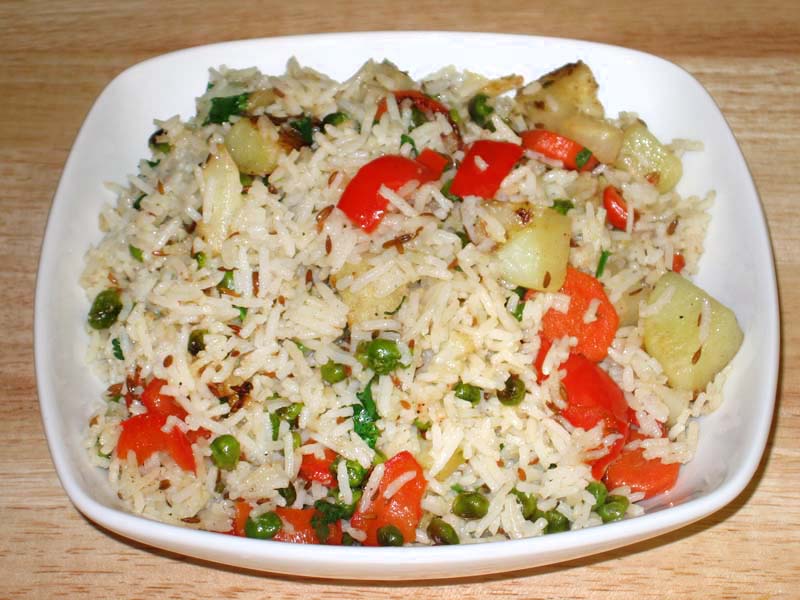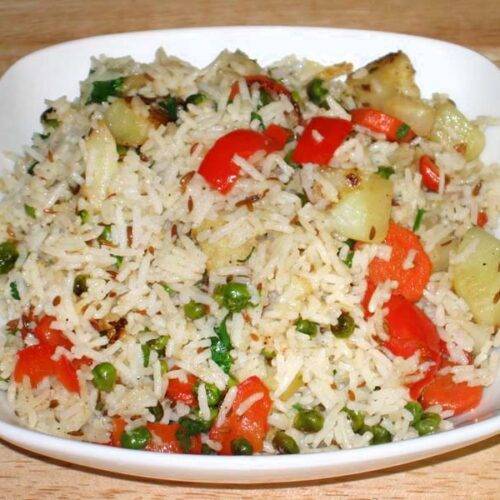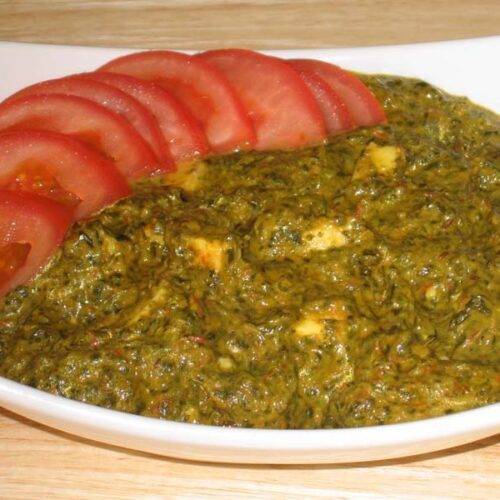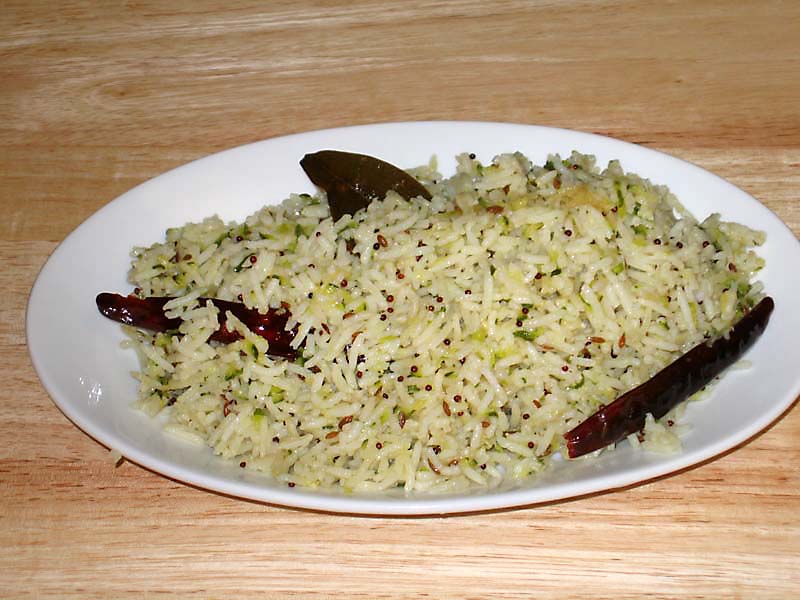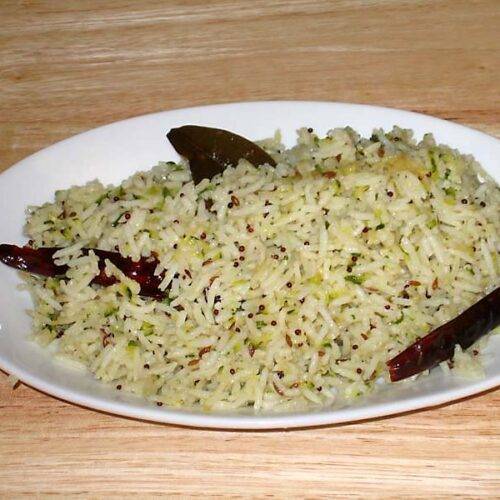Vegetable Rice – Vegetable Pulav
Ingredients
For Rice
- 1 cup basmati or long grain rice
- 2 cup water
- 2 tbsp oil canola, vegetable
- 1 tsp cumin seeds jeera
- 2 bay leaf taj pata
- 1 tsp salt
For Vegetables
- 3 tbsp oil canola, vegetable
- 1 tsp cumin seeds jeera
- 1 medium sized potato, chopped into 1/2″ cubes
- 1 carrot sliced
- 1 cup cauliflower, cut into small pieces
- 1 cup frozen green peas
- 1/2 red bell pepper, chopped
- 2 long sliced green chilies
- 1 tsp grated ginger
- 1 tsp salt
- 1/2 tsp garam masala
- 1 tbsp lemon juice
For Garnishing
- 2 tbsp finely chopped cilantro hara dhania
Instructions
Preparing the rice:
- Heat the oil in a saucepan. Test the oil by adding one cumin seed; if seed cracks right away oil is ready. Add cumin seeds after cumin seeds crack add bay leaves and stir for few seconds. Next add the rice. Stir-fry for 2 minutes.
- Add water and salt, bring to a boil and turn the heat to low. Cover the pan. Cook about 15 minutes, or until the rice is tender and the water has evaporated. Turn off the heat and fluff the rice with a fork.
Preparing the vegetables:
- Use a frying pan to cook the vegetables. Add the vegetables in steps, the vegetables that need the most time to cook are added first and the vegetables that need the least time will be added last.
- Heat the oil in frying pan. Test the heat by adding one cumin seed to the oil; if it cracks right away oil is ready. Add cumin seeds after cumin seeds crack, add potatoes, stir-fry them for about 2 minutes.
- Add cauliflower and carrots. Let them cook for about another 3 minutes, stirring occasionally.
- Next add green peas, bell pepper, ginger and green chilies. Let the vegetables cook for a few minutes till vegetables are tender. Turn off the heat.
- Add garam masala and lemon juice.
- Next gently fold the rice into the vegetables. Transfer to a serving dish and garnish the rice dish with cilantro.
How to make Pulav Rice Recipe – Manjula’s Kitchen
Vegetable pulao is a flavorful gluten-free vegan blend of spicy vegetables combined with rice, making it an excellent lunch option. This dish proves particularly convenient when you prefer a quick & easy meal. Utilize vegetable pulav as a standalone one-dish meal, or complement it with yogurt, pickle, papadam, or chutney for a satisfying and well-rounded dining experience.
Preparing Pulav Rice:
Embark on a culinary adventure as you delve into the meticulous process of crafting a delightful pulav rice recipe. Begin by heating oil in a saucepan, creating a canvas for the infusion of rich flavors. Ensure the oil is at the optimal temperature by conducting a cumin seed test; the satisfying crackle indicates readiness. Enrich the aromatic foundation by introducing additional cumin seeds and fragrant bay leaves, setting the stage for an enticing pulav rice experience.
As you add the rice to the pan, engage in a 2-minute stir-fry, allowing each grain to absorb the essence of the spices—a vital step in mastering the art of how to make pilav rice. The introduction of water and salt transforms the mixture into a bubbling concoction, simmering on low heat for 15 minutes until the rice attains a tender texture, releasing a fragrant aroma that defines the pulav rice recipe. Conclude this flavorful journey by delicately fluffing the rice with a fork, achieving a light and fluffy consistency crucial to the essence of the rice pulav recipe.
Preparing Vegetables for Pulav Rice:
In the intricate process of creating pulav rice, wield a frying pan as your culinary orchestra, orchestrating a symphony of vibrant colors and enticing textures. Elevate the aromatic canvas by heating oil to the perfect temperature, validated by the distinctive crackle of a cumin seed—the quintessential initiation into the pulav rice recipe. With each addition of cumin seeds, establish a fragrant base that paves the way for the culinary dance that follows.
Immerse potatoes into this aromatic blend, conducting a 2-minute stir-fry, a pivotal step in unraveling the secrets of how to make pulav rice. Introduce cauliflower and carrots, orchestrating an additional 3 minutes of cooking to gradually enhance their tenderness, a crucial aspect in the art of rice pulav. The crescendo of this culinary symphony includes green peas, bell pepper, ginger, and green chilies, creating a vibrant medley that transforms the pulav rice recipe into a visual and flavorful masterpiece. Conclude this vegetable overture by introducing garam masala and lemon juice, harmoniously blending the spices before gently folding the aromatic rice into the vegetable symphony, shaping the pulav rice recipe.
Final Assembly of Rice Pulav:
Culminate the gastronomic masterpiece that is the pulav rice recipe by seamlessly merging the meticulously prepared rice and vegetables. Gently fold the aromatic rice into the medley of colorful vegetables, ensuring an even distribution of flavors—a key element in the intricate art of making pulav rice. As the harmonious blend takes shape, transfer it to a serving dish, where the vibrant hues of the vegetables complement the inviting warmth of the rice pulav.
Elevate the presentation by adorning the dish with sprigs of fresh cilantro, adding a final touch of both freshness and visual appeal—a crucial finale in the rice pulav recipe. This assembly not only showcases the meticulous steps involved in creating a pulav rice dish that tantalizes taste buds but also captivates with its aesthetic allure. Serve and savor the culmination of the pulav rice recipe—a delightful union of fragrant rice and flavorful vegetables—embodied in the artistry of pulav preparation.
If you loved our recipe of vegetable pulav then you must also check out other variants of Rice: Vegetable Biryani, Masala Khichdi, Chhole Biryani, Quinoa Vegetable Pilaf, and Lemon Rice.

